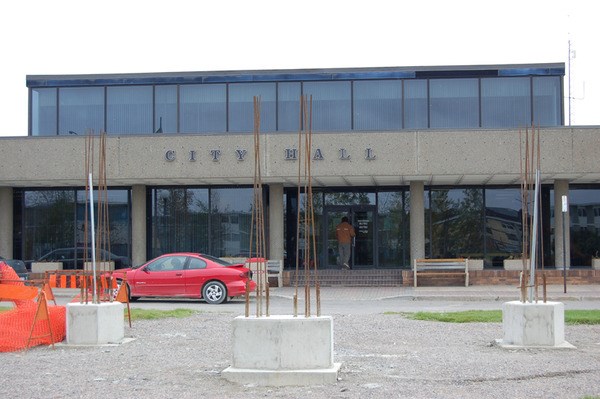Story:
Local jeweller Don Johnson Jr. has been in the "Thompson Clock" game for too long now - four years, thanks for asking, he might say - to be foolish enough to make a definitive prediction about when the Thompson Clock will be mounted and ticking in front of City Hall, but not later than July 1 is the current thinking.
Johnson hopes this will be the final countdown for the installation of a community clock honouring John Fairfield Thompson, the chairman of International Nickel Company of Canada Limited when Borehole 11962 - the so-called "Discovery Hole" at Cook Lake, a diamond drill exploration hole - was collared Feb. 5, 1956 and assayed positive for nickel. The clock is a 50th anniversary project dating back to 2006.
Thompson became president of Inco in 1949, a position he held for three years until 1952. He became chairman in 1951 and remained in that role until his retirement in April 1960.
At a meeting May 17, Mayor Tim Johnston asked Wayne Hall if he would have the time to spearhead the drive to get the clock up under Don Johnson's direction. Hall agreed, and together with Nick DiVirgilio, the duo is in charge of making the final push as directed by Don Johnson.
One of the things needed is a cement contractor to "form and make" the exposed aggregate to finish the vertical columns, Johnson needs, he says. He believes someone has been lined up for that.
The underground foundation and cement work is complete and in place in front of City Hall; the metal tubing, which will be the upper portion of the clock and will hold the two faces has been fabricated and is ready to go; dies and jigs to ensure that all independent parts will fit together are complete. What are still required are the surface bases and the tubes used for the six columns.
The final design represents twin clocks, each six feet in diameter, standing in a V-shape on pillars matching those of City Hall, one facing northwest and the other southwest.
Dual steel pipes will connect the identical clocks, manufactured in Massachusetts, with the entire structure standing 18 feet tall and 21 feet wide.
The clock faces will also be lit, with special engineering employed to handle Thompson's cold winters. Ground lighting will also keep the clocks looking bright year-round.
The two clock faces and electronic controls for the community clock 50th anniversary project are sitting in a warehouse in Thompson. They have been for more than two years.
Johnson had his work cut out for him pulling together details of the Thompson clock's construction from day one.
"It's the biggest watch I've ever designed," he told the Thompson Citizen in December 2007.
Johnson spent a significant portion of his time researching before drawing the first design sketch. He wanted the clock to have the same look as its City Hall backdrop, while remaining unique.
After consultation amongst others working on the project, it came to Johnson's attention that a timepiece has 12 hours and early Canadian nickel coins (around the mid-1900s) have 12 sides.
The choice became obvious to create the design in the shape of a nickel coin, as nickel is the ore, which has become the city's central industry provider.
The concept was brought forward only months, just prior to the 2006 anniversary of Thompson and Inco, Johnson recalled last July, rejecting any notion there had been any delay in getting construction under way. "This is not the case at all," he said, noting "from the design to the raising of funds, from concept to construction, this entire project has been at the mercy of the time available, by the volunteers. The presentation was made at the 50th and has never stopped moving forward."The foundation was put in place in the fall of 2008, "compliments of Schwartz Bros." Construction, Johnson said. Mutschel Bros. constructed the steelwork, including the tower and pedestal that it will rest on, and the cement for the base was donated by Multicrete Systems Inc.
From the beginning of his career with Inco, in 1906,
John Fairfield Thompson played important roles in developing and encouraging the expanded use of various nickel alloys, introducing them to the textile, chemical, power and food service industries.
In 1918, he established the first technical department.
Following the First World War, when Inco wanted to expand its commercial markets. Thompson was responsible for supervising both the construction and initial operations of a rolling mill in Huntington, West Virginia.
His laboratory experience, combined with a practical approach to product development contributed to the successful production of new alloys for commercial use. He guided Inco toward making new products such as nickel alloy wire and tubing.
In 1948, Thompson approved funding for a project to develop the stainless steel kitchen sink, the single largest application of the alloy in the world. Thompson became president of Inco in 1949, a position he held for three years until 1952. He became chairman in 1951 and remained in that role until his retirement in April 1960.




